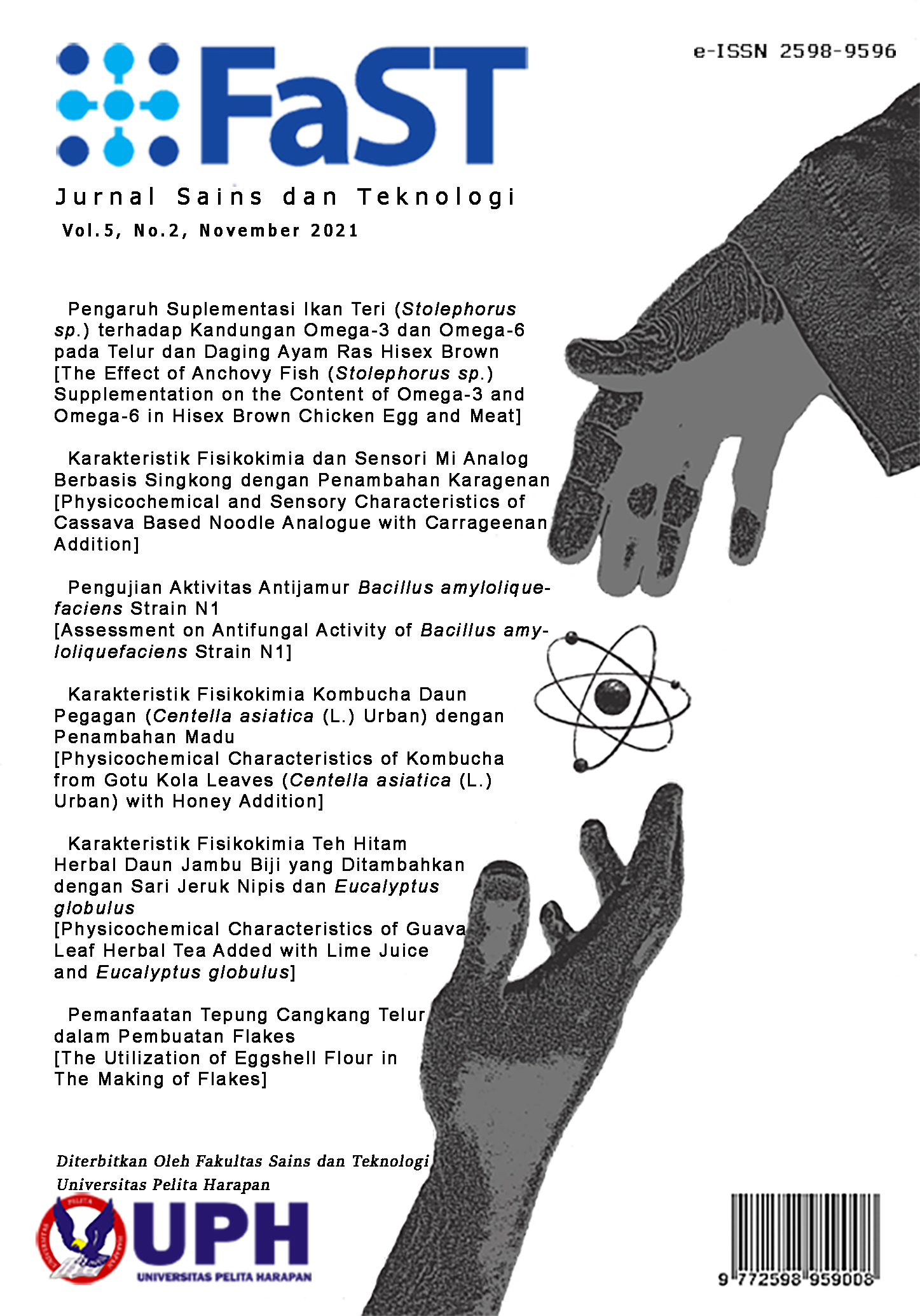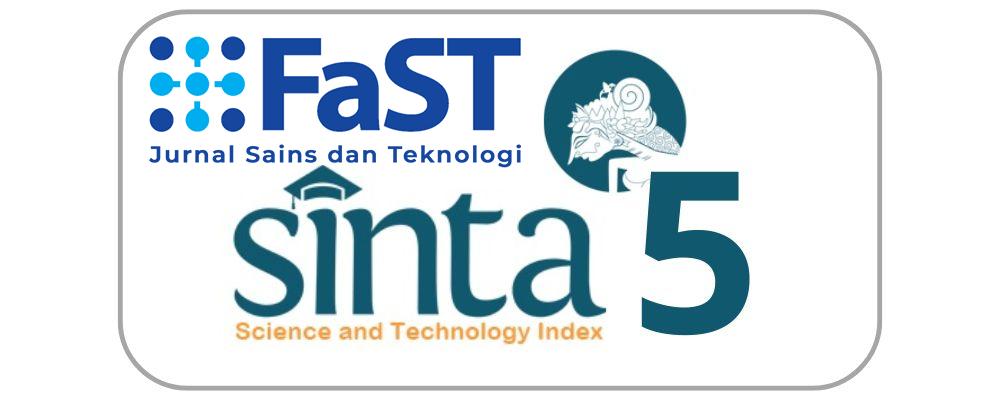KARAKTERISTIK FISIKOKIMIA TEH HITAM HERBAL DAUN JAMBU BIJI YANG DITAMBAHKAN DENGAN SARI JERUK NIPIS DAN Eucalyptus globulus [PHYSICOCHEMICAL CHARACTERISTICS OF GUAVA LEAF HERBAL TEA WITH ADDED LIME JUICE AND Eucalyptus globulus]
Keywords:
daun jambu biji, Eucalyptus globulus, jeruk nipis, penyeduhan, teh herbal, brewing, guava leaf, herbal tea, lime juiceAbstract
Guava leaves can be utilized as herbal tea because it contains bioactive compounds. In this research, guava leaf herbal tea was prepared according to black tea making process. Guava leaf herbal tea tends to have an astringent taste, therefore lime juice and Eucalyptus globulus were added to improve the sensory characteristics. The purpose of this study was to determine the best brewing temperature and time, and the effect of lime juice concentration and E. globulus essential oil on physicochemical and sensory properties of guava leaf herbal tea. In the first stage research, guava leaf herbal tea was brewed at different temperature (70, 80, 90oC) and time (5, 10, 15 minutes). The selected brewing temperature and time was 90oC for 10 minutes, with antioxidant activity (IC50) of 4372.22±54.71 ppm, total phenolic of 292.88±8.35 mg GAE/L, total flavonoids of 80.83±1.61 mg QE/L, and condensed tannin of 543.10 ±38.68 mg CE/L. In the second research stage, guava leaf herbal tea was prepared with the addition of lime (1, 2, 3%) and E. globulus (0,05, 0,10, 0,15%). When compared to herbal teas without the addition of lime and E. globulus, guava leaf herbal tea with addition of 3% lime and 0,15% E. globulus has lower antioxidant activity (IC50) of 10199.18±289.35 ppm, total phenolic of 303.12±19.70 mg GAE/L, total flavonoids of 78.20±3.52 mg QE/L, and condensed tannins of 362.40±12.40 mg CE/L. However, addition of lime and E. globulus to the guava leaf herbal tea increased the panelists' preference in terms of color and astringency.
BAHASA INDONESIA ABSTRAK:
Daun jambu biji dapat dimanfaatkan menjadi teh herbal dikarenakan memiliki kandungan senyawa bioaktif. Pembuatan teh herbal daun jambu biji pada penelitian ini menggunakan proses pembuatan teh hitam. Teh herbal daun jambu biji cenderung memiliki rasa sepat sehingga ditambahkan sari jeruk nipis dan Eucalyptus globulus untuk meningkatkan karakteristik sensorinya. Tujuan dari penelitian ini adalah menentukan perlakuan suhu dan waktu penyeduhan terpilih, serta pengaruh penambahan konsentrasi sari jeruk nipis dan minyak esensial E. globulus terhadap karakteristik fisikokimia serta sensori teh herbal daun jambu biji. Penelitian tahap I dilakukan pembuatan daun teh jambu biji kering dan penyeduhan teh herbal daun jambu biji pada suhu (70, 80, 90oC) dan waktu penyeduhan (5, 10, 15 menit). Suhu dan waktu penyeduhan terpilih adalah suhu 90oC selama 10 menit, yang memiliki aktivitas antioksidan (IC50) sebesar 4372,22±54,71 ppm, total fenolik 292,88±8,35 mg GAE/L, total flavonoid 80,83±1,61 mg QE/L, dan kandungan tanin terkondensasi 543,10±38,68 mg CE/L. Pada penelitian tahap II, dilakukan pembuatan teh herbal daun jambu biji dengan penambahan konsentrasi jeruk nipis (1, 2, 3%) dan E. globulus (0,05, 0,10, 0,15%). Jika dibandingkan dengan teh herbal tanpa penambahan E. globulus dan jeruk nipis, teh herbal daun jambu biji dengan penambahan jeruk nipis 3% dan E. globulus 0,15% memiliki aktivitas antioksidan (IC50) yang lebih rendah, yaitu sebesar 10199,18±289,35 ppm, total fenolik 303,12±19,70 mg GAE/L, total flavonoid 78,20±3,52 mg QE/L, dan kandungan tanin terkondensasi 362,40±12,40 mg CE/L. Namun, penambahan jeruk nipis dan E. globulus pada teh herbal daun jambu biji meningkatkan tingkat kesukaan panelis terhadap warna dan rasa sepat.
References
Albab, U., Nirwana, R., & Firmansyah, R. (2018). Aktivitas antioksidan daun jambu air (Syzygium samarangense (BL.) Merr Et. Perry) serta optimasi suhu dan lama penyeduhan. Walisongo Journal of Chemistry, 2(1), 18-30.
Amanto, B., Aprilia, T., & Nursiwi, A. (2019). Pengaruh lama blanching dan rumus petikan daun terhadap karakterisktik fisik, kimia, serta sensoris teh daun tin (Ficus carica). Jurnal Teknologi Hasil Pertanian, 12(1), 1-11.
Anggraini, T., Febrianti, F., & Ismanto, S. (2016). Black tea with Averrhoa Bilimbi L extract: a healthy beverage. Agriculture and Agricultural Science Procedia, 9, 241-252.
AOAC. (2005). Official methods of analysis of the associates of official analytical chemist (16th ed.). Virginia.
Boukhatem, M., Boumaiza, A., Nada, H., Rajabi, M., & Mousa, S. (2020). Eucalyptus globulus essential oil as a natural food preservative: antioxidant, antibacterial and antifungal properties in vitro and in a real food matrix (Orangina fruit juice). Applied Sciences, 10(16), 1-17.
BSN (Badan Standardisasi Nasional). (2004). Air dan air limbah - bagian 11: cara uji derajat keasaman (pH) dengan menggunakan alat pH meter. SNI 06-6989.11-2004. Banten: Badan Standardisasi Nasional.
BSN (Badan Standardisasi Nasional). (2006). Petunjuk pengujian organoleptik dan atau sensori. SNI 01-2346-2006. Jakarta: Badan Standardisasi Nasional.
BSN (Badan Standardisasi Nasional). (2013). Teh kering dalam kemasan. SNI 3836: 2013. Jakarta: Badan Standardisasi Nasional.
Chakrabarti, G., Bhattacharjee, S., & Bhattacharyya, S. (2017). Evaluation of antioxidant profile and phytochemical constituents of some herb-supplemented black tea infusions. Int J Pharm Pharm Sci, 9(12), 131-135.
Chandrasekara, A. & Shahidi, F. (2018). Herbal beverages: bioactive compounds and their role in disease risk reduction - a review. Journal of Traditional and Complementary Medicine, 8(4), 451-458.
Dewata, I., Wipradnyadewi, P., & Widarta, I. (2017). Pengaruh suhu dan lama penyeduhan terhadap aktivitas antioksidan dan sifat sensoris teh herbal daun alpukat (Persea americana Mill.), Jurnal ITEPA, 6(2), 30-39.
Dezsi, Ș., Bădărău, A., Bischin, C., Vodnar, D., Silaghi-Dumitrescu, R., Gheldiu, A., Mocan, A., & Vlase, L. (2015). Antimicrobial and antioxidant activities and phenolic profile of Eucalyptus globulus Labill. and Corymbia ficifolia (F. Muell.) K.D. Hill & L.A.S. Johnson leaves. Molecules, 20(3), 4720-4734.
Dusun, C., Djarkasi, G., Tehlma, D., & Tuju, J. (2017). Kandungan polifenol dan aktivitas antioksidan teh daun jambu biji (Psidium guajava L). In Cocos, 1(7), 1-15.
Enko, J. & Gliszczyńska-Świgło, A. (2015). Influence of the interactions between tea (Camellia sinensis) extracts and ascorbic acid on their antioxidant activity: analysis with interaction indexes and isobolograms. Food Additives & Contaminants: Part A, 32(8), 1-9.
Hardoko, H., Putri, T. S., & Eveline, E. (2015). In vitro anti-gout activity and phenolic content of” black tea” soursop Annona muricata L. leaves brew. Journal of Chemical and Pharmaceutical Research, 7(11), 735-743.
Javanmardi, J., Stushnoff, C., Locke, E., & Vivanco, J. (2003). Antioxidant activity and total phenolic content of Iranian Ocimum accessions. Food Chemistry, 83, 547-550.
Lamien-Meda, A., Lamien, C., Compaoré, M., Meda, R., Kiendrebeogo, M., Zeba, B., Millogo, J., & Nacoulma, O. (2008). Polyphenol content and antioxidant activity of fourteen wild edible fruits from Burkina Faso. Molecules, 13(3), 581-594.
Lestari, M., Saleh, E., & Rasulu, H. (2018). Pengaruh umur daun pala dan jenis pengeringan terhadap sifat kimia dan organoleptik teh herbal daun pala. Techno: Jurnal Penelitian, 7(2), 177-190.
Parlina, S. (2012). Study of antioxidant characteristics of cider prepared from pomegranate (Punica granatum L.) fruit peels. Tangerang, Indonesia: Universitas Pelita Harapan, Bachelor Thesis.
Purwandari, R., Subagiyo, S., & Wibowo, T. (2018). Uji aktivitas antioksidan ekstrak daun jambu biji. Walisongo Journal of Chemistry, 1(2), 67-72.
Putra, A. (2019). Pengawasan mutu proses produksi teh hitam (studi kasus di pabrik teh sumber daun di desa Hegarmanah Kecamatan Takokak Kabupaten Cianjur). Ummi, 13(1), 1-6.
Said, Z., Slimani, S., Remini, H., Idir-Himed, H., Mazauric, J., Madani, K., & Boulekbache-Makhlouf, L. (2015). Phytochemical analysis and antioxidant activity of Eucalyptus globulus: a comparative study between fruits and leaves extracts. SDRP Journal of Chemical Engineering & Bioanalytical Chemistry, 1(1), 1-10.
Sari, D., Affandi, D., & Prabawa, S. (2019). Pengaruh waktu dan suhu pengeringan terhadap karakteristik teh daun tin (Ficus carica L.). Jurnal Teknologi Hasil Pertanian, 12(2), 68-77.
Shannon, E., Jaiswal, A., & Abu-Ghannam, N. (2018). Polyphenolic content and antioxidant capacity of white, green, black, and herbal teas: a kinetic study. Food Research, 2(1), 1-11.
Sipahelut, S., Tetelepta, G., & Patty, J. 2017. Kajian penambahan minyak atsiri dari daging buah pala (Myristica fragrans Houtt.) pada cake terhadap daya terima konsumen. Jurnal Sains dan Teknologi Pangan, 2(2), 486-495.
Samosir, P., Tafzi, F., & Indriyani, I. (2018). Pengaruh metode pengeringan daun pedada (Sonneratia caseolaris) untuk membuat minuman fungsional sebagai sumber antioksidan. Prosiding Seminar Nasional Pembangunan Pertanian Berkelanjutan Berbasis Sumber Daya Lokal, p. 318-342. Jambi, Indonesia : Fakultas Pertanian Universitas Jambi.
Sudira, I., Merdana, I., & Qurani, S. (2019). Preliminary phytochemical analysis of guava leaves (Psidium guajava L.) as antidiarrheal in calves. Advances in Tropical Biodiversity and Environmental Sciences, 3(2), 21-24.
Sudjatini, S. (2016). Sifat pro-oksidan sari jeruk nipis (Citrus aurentifolia) terhadap aktifitas antioksidan teh hijau (Camellia sinensis). Agrotech, 1(1), 19-26.
Tanjung, R., Hamzah, F., & Efendi, R. (2016). Lama fermentasi terhadap mutu teh daun sirsak (Annona muricata L.). Jurnal Online Mahasiswa Fakultas Pertanian Universitas Riau, 3 (2), 1-9.
Teshome, K. (2019). Effect of tea processing methods on biochemical composition and sensory quality of black tea (Camellia sinensis (L.) O. Kuntze): A review. Journal of Horticulture and Forestry, 11(6), 84-95.
Yuniartini, N., Kusnadi, J., & Zubaidah, E. (2015). Teh Effect of various tea processing methods on antioxidant activity of guava (Psidium guajava L. Var Pomifera) leaves tea in East Java Indonesia. International Journal of Pharmacy Technology, 7(4), 580-586.
Zuraida, Z., Sulistiyani, S., Sajuthi, D., & Suparto, I. 2017. Fenol, flavonoid, dan aktivitas antioksidan pada ekstrak kulit batang pulai (Alstonia scholaris R. Br). Jurnal Penelitian Hasil Hutan, 35(3), 211-219.

Downloads
Published
Issue
Section
License
“Authors who publish with this journal agree to the following terms:
1) Authors retain copyright and grant the journal right of first publication with the work simultaneously licensed under a Creative Commons Attribution License (CC-BY-SA 4.0) that allows others to share the work with an acknowledgement of the work's authorship and initial publication in this journal.
2) Authors are able to enter into separate, additional contractual arrangements for the non-exclusive distribution of the journal's published version of the work (e.g., post it to an institutional repository or publish it in a book), with an acknowledgement of its initial publication in this journal.
3) Authors are permitted and encouraged to post their work online (e.g., in institutional repositories or on their website). The final published PDF should be used and bibliographic details that credit the publication in this journal should be included.”




